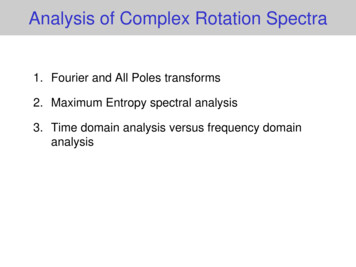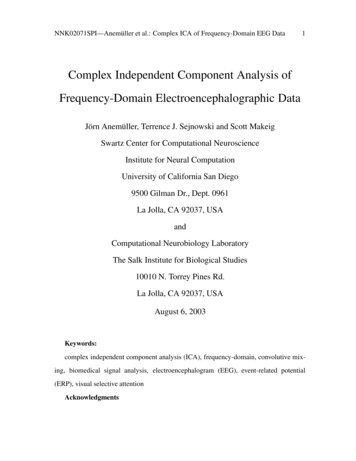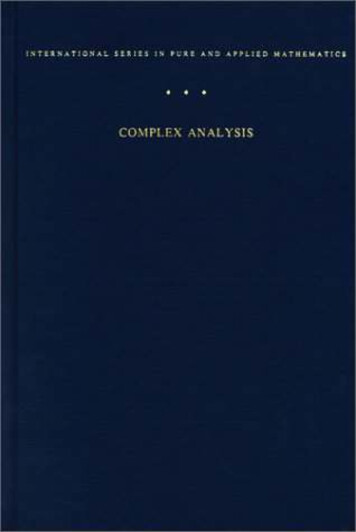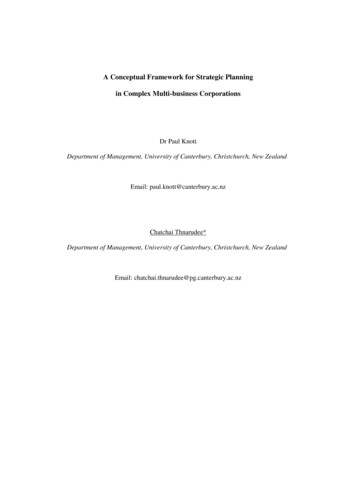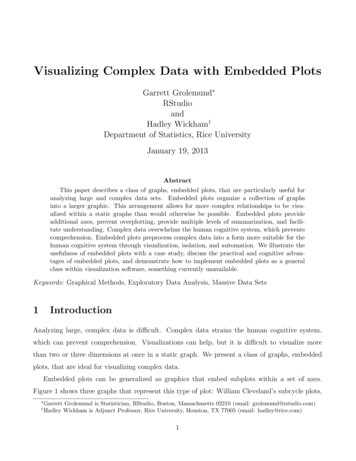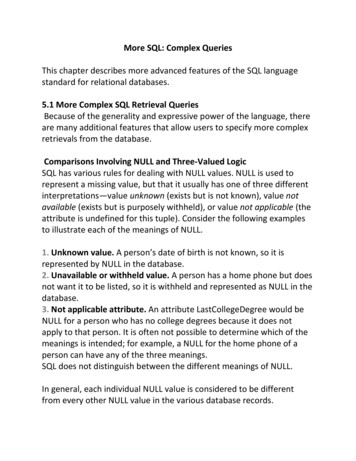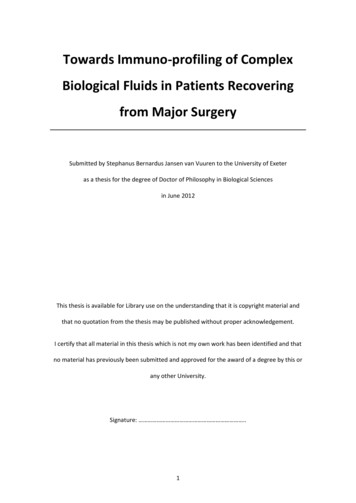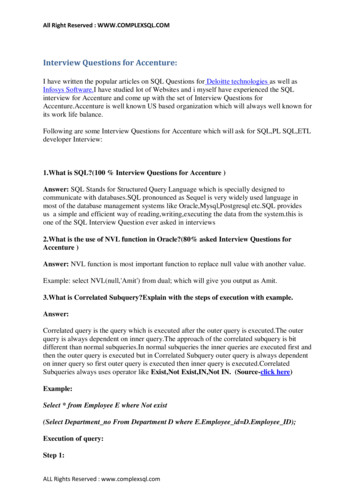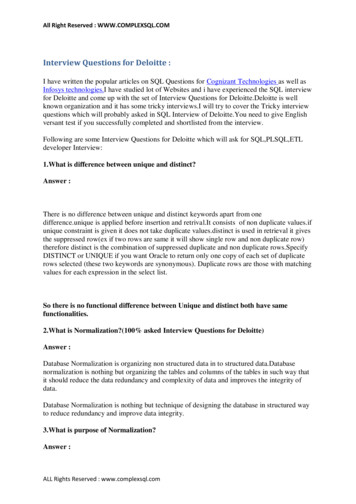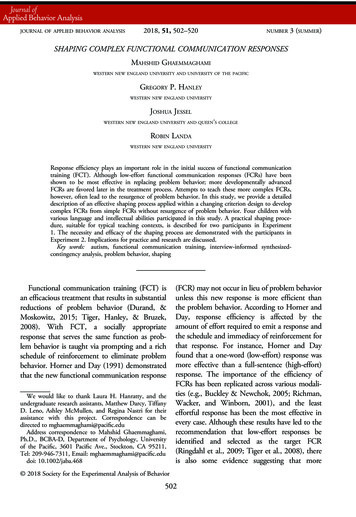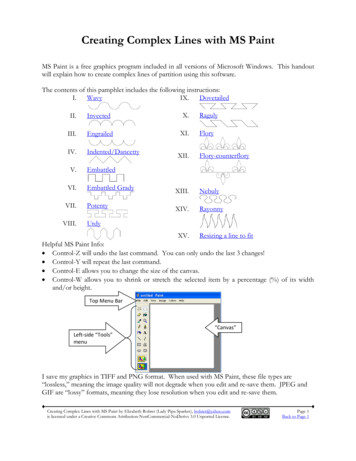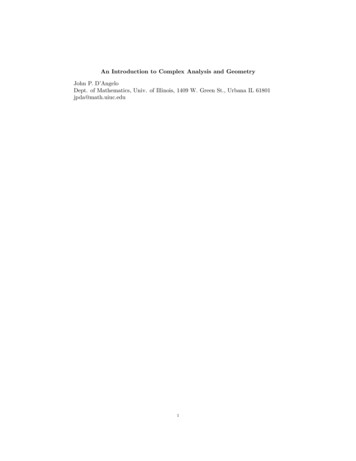
Transcription
An Introduction to Complex Analysis and GeometryJohn P. D’AngeloDept. of Mathematics, Univ. of Illinois, 1409 W. Green St., Urbana IL 61801jpda@math.uiuc.edu1
2c 2009 by John P. D’Angelo
ContentsChapter 1. From the real numbers to the complex numbers1. Introduction2. Number systems3. Inequalities and ordered fields4. The complex numbers5. Alternative definitions of C6. A glimpse at metric spaces11111116242630Chapter 2. Complex numbers1. Complex conjugation2. Existence of square roots3. Limits4. Convergent infinite series5. Uniform convergence and consequences6. The unit circle and trigonometry7. The geometry of addition and multiplication8. Logarithms353537394144505354Chapter 3. Complex numbers and geometry1. Lines, circles, and balls2. Analytic geometry3. Quadratic polynomials4. Linear fractional transformations5. The Riemann sphere595962636973Chapter 4. Power series expansions1. Geometric series2. The radius of convergence3. Generating functions4. Fibonacci numbers5. An application of power series6. Rationality75757880828587Chapter 5. Complex differentiation1. Definitions of complex analytic function2. Complex differentiation3. The Cauchy-Riemann equations4. Orthogonal trajectories and harmonic functions5. A glimpse at harmonic functions6. What is a differential form?3919192949798103
4CONTENTSChapter 6. Complex integration1. Complex-valued functions2. Line integrals3. Goursat’s proof4. The Cauchy integral formula5. A return to the definition of complex analytic function107107109116119124Chapter 7. Applications of complex integration1. Singularities and residues2. Evaluating real integrals using complex variables methods3. Fourier transforms4. The Gamma function127127129136138Chapter 8. Additional Topics1. The minimum-maximum theorem2. The fundamental theorem of algebra3. Winding numbers, zeroes, and poles4. Pythagorean triples5. Elementary mappings6. Quaternions7. Higher dimensional complex analysisFurther ndex167
CONTENTS5PrefaceThis book developed from a course given in the Campus Honors Program at theUniversity of Illinois Urbana-Champaign in the fall semester 2008. The aims of thecourse were to introduce bright students, most of whom were freshmen, to complexnumbers in a friendly, elegant fashion and to develop reasoning skills belonging tothe realm of elementary complex geometry. In the spring semester 2010 I taughtanother version of the course, in which a draft of this book was available on-line. Itherefore wish to acknowledge the Campus Honors Program at UIUC for allowingme to teach these courses and to thank the 27 students who participated in them.Many elementary mathematics and physics problems seem to simplify magicallywhen viewed from the perspective of complex analysis. My own research interestsin functions of several complex variables and CR geometry have allowed me towitness this magic daily. I continue the preface by mentioning some of the specifictopics discussed in the book and by indicating how they fit into this theme.Every discussion of complex analysis must spend considerable time with powerseries expansions. We include enough basic analysis to study power series rigorouslyand to solidify the backgrounds of the typical students in the course. In some sensetwo specific power series dominate the subject: the geometric and exponentialseries.The geometric series appears all throughout mathematics and physics, and evenin basic economics. The Cauchy integral formula provides a way of deriving fromthe geometric series the power series expansion of an arbitrary complex analyticfunction. Applications of the geometric series appear throughout the book.The exponential series is of course also crucial. We define the exponentialfunction via its power series, and we define the trigonometric functions by way ofthe exponential function. This approach reveals the striking connections betweenthe functional equation ez w ez ew and the profusion of trig identities. Usingthe complex exponential function to simplify trigonometry is a compelling aspectof elementary complex analysis and geometry. Students in my courses seemed toappreciate this material to a great extent.One of the most appealing combinations of the geometric series and the exponential series appears in Chapter 4. We combine them to derive a formula for thesumsnXjp,j 1in terms of Bernoulli numbers.We briefly discuss ordinary and exponential generating functions, and we findthe ordinary generating function for the Fibonacci numbers. We then derive Binet’s formula for the n-th Fibonacci number and show that the ratio of successiveFibonacci numbers tends to the golden ratio 1 2 5 .Fairly early in the book (Chapter 3) we discuss hyperbolas, ellipses, and parabolas. Most students have seen this material in calculus or even earlier. In order tomake the material more engaging, we describe these objects by way of Hermitiansymmetric quadratic polynomials. This approach epitomizes our focus on complexnumbers rather than on pairs of real numbers.
6CONTENTSThe geometry of the unit circle also allows us to determine the Pythagoreantriples. We identify the Pythagorean triple (a, b, c) with the complex number ac i cb ;we then realize that a Pythagorean triple corresponds to a rational point (in the firstquadrant) on the unit circle. After determining the usual rational parametrizationof the unit circle, one can easily find all these triples. But one gains much more; forexample, one discovers the so-called tan( θ2 ) substitution from calculus. During thecourse several students followed up this idea and tracked down how the indefiniteintegral of the secant function arose in navigation.This book is more formal than was the course itself. The list of approximatelytwo hundred eighty exercises in the book is also considerably longer than the list ofassigned exercises. These exercises are numbered by Chapter, whereas items suchas Theorems, Propositions, and Definitions are numbered by Section. The overalldevelopment in the book closely parallels that of the courses, although each timeI omitted many of the harder topics. I feel cautiously optimistic that this bookcan be used for similar courses. Instructors will need to make their own decisionsabout which subjects can be omitted. I hope however that the book has a wideraudience including anyone who has ever been curious about complex numbers andthe striking role they play in modern mathematics and science.Chapter 1 starts by considering various number systems and continues by describing, slowly and carefully, what it means to say that the real numbers area complete ordered field. We give an interesting proof that there is no rationalsquare root of 2, and we prove carefully (based on the completeness axiom) thatpositive real numbers have square roots. The chapter ends by giving several possibledefinitions of the field of complex numbers.Chapter 2 develops the basic properties of complex numbers, with a special emphasis on the role of complex conjugation. The author’s own research in complexanalysis and geometry has often used polarization; this technique makes precise thesense in which we may treat z and z as independent variables. We will view complexanalytic functions as those independent of z. In this chapter we also include precise definitions about convergence of series and related elementary analysis. Someinstructors will need to treat this material carefully, while others will wish to review it quickly. Section 5 treats uniform convergence and some readers will wishto postpone this material. The subsequent sections however return to the basics ofcomplex geometry. We define the exponential function by its power series and thecosine and sine functions by way of the exponential function. We can and thereforedo discuss logarithms and trigonometry in this chapter as well.Chapter 3 focuses on geometric aspects of complex numbers. We analyze thezero-sets of quadratic equations from the point of view of complex rather thanreal variables. For us hyperbolas, parabolas, and ellipses are zero-sets of quadraticHermitian symmetric polynomials. We also study linear fractional transformationsand the Riemann sphere.Chapter 4 considers power series in general; students and instructors will findthat this material illuminates the treatment of series from calculus courses. Thechapter includes a short discussion of generating functions, Binet’s formula for theFibonacci numbers, and the formula for sums of p-th powers mentioned above. Weclose Chapter 4 by giving a test for when a power series defines a rational function.Chapter 5 begins by posing three possible definitions of complex analytic function. These definitions involve locally convergent power series, the Cauchy-Riemann
CONTENTS7equations, and the limit quotient version of complex differentiability. We postponethe proof that these three definitions determine the same class of functions untilChapter 6 after we have introduced integration. Chapter 5 focuses on the relationship between real and complex derivatives. We define the Cauchy-Riemann equa operator. Thus complex analytic functions are those functionstions using the zindependent of z. This perspective has profoundly influenced research in complexanalysis, especially in higher dimensions, for at least fifty years. We briefly consider harmonic functions and differential forms in Chapter 5; for some audiencesthere might be too little discussion about these topics. It would be nice to developpotential theory in detail and also to say more about closed and exact differentialforms, but then perhaps too many readers would drown in deep water.Chapter 6 treats the Cauchy theory of complex analytic functions in a simplifiedfashion. The main point there is to show that the three possible definitions of analytic function introduced in Chapter 5 all lead to the same class of functions. Thismaterial forms the basis for both the theory and application of complex analysis.In short, Chapter 5 considers derivatives and Chapter 6 considers integrals.Chapter 7 offers many applications of the Cauchy theory to ordinary integrals.In order to show students how to apply complex analysis to things they have seenbefore, we evaluate many interesting real integrals using residues and contour integration. We also include sections on the Fourier transform on the Gamma function.Chapter 8 introduces additional appealing topics such as the fundamental theorem of algebra (for which we give three proofs), winding numbers, Rouche’s theorem, Pythagorean triples, conformal mappings, the quaternions, and (a brief mention of) complex analysis in higher dimensions. The section on conformal mappingsincludes a brief discussion of non-Euclidean geometry. The section on quaternionsincludes the observation that there are many quaternionic square roots of 1, andhence it illuminates the earliest material used in defining C. The final result provedconcerns polarization; it justifies treating z and z as independent variables, andhence it also unifies much of the material in book.Our bibliography includes many excellent books on complex analysis in onevariable. One naturally asks how this book differs from those. The primary difference is that this book begins at a more elementary level. We start at the logicalbeginning, by discussing the natural numbers, the rational numbers, and the realnumbers. We include detailed discussion of some truly basic things, such as the existence of square roots of positive real numbers, the irrationality of 2, and severaldifferent definitions of C itself. Hence most of the book can be read by a smartfreshman who has had some calculus, but not necessarily any real analysis. Asecond difference arises from the desire to engage an audience of bright freshmen.I therefore include discussion, examples, and exercises on many topics known tothis audience via real variables, but which become more transparent using complexvariables. My ninth grade math class (more than forty years ago) was tested on being able to write word-for-word the definitions of hyperbola, ellipse, and parabola.Most current college freshmen know only vaguely what these objects are, and Ifound myself reciting those definitions when I taught the course. During class Ialso paused to carefully prove that .999. really equals 1. Hence the book containsvarious basic topics, and as a result it enables spiral learning. Several conceptsare revisited with high multiplicity throughout the book. A third difference from
8CONTENTSthe other books arises from the inclusion of several unusual topics, as describedthroughout this preface.I hope, with some confidence, that the text conveys my deep appreciation forcomplex analysis and geometry. I hope, but with more caution, that I have purgedall errors from it. Most of all I hope that many readers enjoy reading it and solvingthe exercises in it.I began expanding the sketchy notes from the course into this book during thespring 2009 semester, during which I was partially supported by the Kenneth D.Schmidt Professorial Scholar award. I therefore wish to thank Dr. Kenneth Schmidtand also the College of Arts and Sciences at UIUC for awarding me this prize. I havereceived considerable research support from NSF for my work in complex analysis;in particular I acknowledge support from NSF grant DMS-0753978. The students inthe first version of the course survived without a text; their enthusiasm and interestmerit praise. Over the years many other students have inspired me to think carefullyhow to present complex analysis and geometry with elegance. Another positiveinfluence on the evolution from sketchy notes to this book was working through someof the material with Bill Heiles, Professor of Piano at UIUC and one who appreciatesthe art of mathematics. Jing Zou, computer science student at UIUC, prepared thefigures in the book. Tom Forgacs, who invited me to speak at Cal. State Fresnoon my experiences teaching this course, also made useful comments. My colleagueJeremy Tyson made many valuable suggestions on both the mathematics and theexposition. I thank Sergei Gelfand and Ed Dunne of the American Math Societyfor encouraging me in this project; Ed Dunne provided me marked-up versions oftwo drafts and shared with me, in a lengthy phone conversation, his insights onhow to improve and complete the project. I asked several friends to look at theN -th draft for various large N . Bob Vanderbei, Rock Rodini, and Mike Bolt allmade many useful comments which I have incorporated. Finally I thank my wifeAnnette and our four children for their love.Preface for the studentI hope that this book reveals the beauty and usefulness of complex numbers toyou. I want you to enjoy both reading it and solving the problems in it. Perhaps youwill spot something in your own area of interest and benefit from applying complexnumbers to it. Students in my classes have found applications of ideas from thisbook to physics, music, engineering, and linguistics. Several students have becomeinterested in historical and philosophical aspects of complex numbers. I have notyet seen anyone get excited about the hysterical aspects of complex numbers.At the very least you should see many places where complex numbers shed anew light on things you have learned before. One of my favorite examples is trigidentities. I found them rather boring in high school and later I delighted in provingthem more easily using the complex exponential function. I hope you have the sameexperience. A second example concerns certain definite integrals. The techniquesof complex analysis allow for stunningly easy evaluations of many calculus integralsand seem to lie within the realm of science fiction.This book is meant to be readable, but at the same time it is precise and rigorous. Sometimes mathematicians include details that others feel are unnecessary orobvious, but do not be alarmed. If you do many of the exercises and work throughthe examples, then you should learn plenty and enjoy doing it. I cannot stress
CONTENTS9enough two things I have learned from years of teaching mathematics. First, students make too few sketches. You should strive to merge geometric and algebraicreasoning. Second, definitions are your friends. If a theorem says something abouta concept, then you should develop both an intuitive sense of the concept and thediscipline to learn the precise definition. When asked to verify something on anexam, start by writing down the definition of the something. Often the definitionsuggests exactly what you should do!Some sections and paragraphs introduce more sophisticated terminology thanis necessary at the time, in order to prepare for later parts of the book and evenfor subsequent courses. I have tried to indicate all such places and to revisit thecrucial ideas. In case you are struggling with any material in this book, remaincalm. The magician will reveal his secrets in due time.
CHAPTER 1From the real numbers to the complex numbers1. IntroductionMany problems throughout mathematics and physics illustrate an amazingprinciple; ideas expressed within the realm of real numbers find their most elegant expression through the unexpected intervention of complex numbers. Manyof these delightful interventions arise in elementary, recreational mathematics. Onthe other hand most college students either never see complex numbers in action, orthey wait until the junior or senior year in college, at which time the sophisticatedcourses have little time for the elementary applications. Hence too few studentswitness the beauty and elegance of complex numbers. This book aims to presenta variety of elegant applications of complex analysis and geometry in an accessiblebut precise fashion. We begin at the beginning, by recalling various number systemssuch as the integers Z, the rational numbers Q, and the real numbers R, beforeeven defining the complex numbers C. We then provide three possible equivalentdefinitions. Throughout we strive for as much geometric reasoning as possible.2. Number systemsThe ancients were well aware of the so-called natural numbers, written 1, 2, 3, .Mathematicians write N for the collection of natural numbers together with theusual operations of addition and multiplication. Partly because subtraction is notalways possible, but also because negative numbers arise in many settings such asfinancial debts, it is natural to expand the natural number system to the largersystem Z of integers. We assume that the reader has some understanding of theintegers; the set Z is equipped with two distinguished members, written 1 and 0,and two operations, called addition ( ) and multiplication ( ), satisfying familiarlaws. These operations make Z into what mathematicians call a commutative ringwith unit 1. The integer 0 is special. We note that each n in Z has an additiveinverse n such that(1)n ( n) ( n) n 0.Of course 0 is the only number whose additive inverse is itself.Let a, b be given integers. As usual we write a b for the sum a ( b). Considerthe equation a x b for an unknown x. We learn to solve this equation at ayoung age; the idea is that subtraction is the inverse operation to addition. To solvea x b for x, we first add a to both sides and use (1). We can then substituteb for a x to obtain the solutionx 0 x ( a) a x ( a) b b ( a) b a.11
121. FROM THE REAL NUMBERS TO THE COMPLEX NUMBERSThis simple principle becomes a little more difficult when we work with multiplication. It is not always possible, for example, to divide a collection of n objectsinto two groups of equal size. In other words, the equation 2 a b does not havea solution in Z unless b is an even number. Within Z, most integers ( 1 are theonly exceptions) do not have multiplicative inverses.To allow for division we enlarge Z into the larger system Q of rational numbers.We think of elements of Q as fractions, but the definition of Q is a bit subtle. One50reason for the subtlety is that we want 21 , 24 , and 100all to represent the samerational number, yet the expressions as fractions differ. Several approaches enableus to make this point precise. One way is to introduce the notion of equivalenceclass, and then to define a rational number to be an equivalence class of pairs ofintegers. See [4] or [8] for this approach. A second way is to think of the rationalnumber system as known to us; we then write elements of Q as letters, x, y, u, v andso on, without worrying that each rational number can be written as a fraction ininfinitely many ways. We will proceed in this second fashion. A third way appearsin Exercise 1.2 below. Finally we emphasize that we cannot divide by 0. Surelythe reader has seen alleged proofs that, for example, 1 2, where the only error isa cleverly disguised division by 0.Exercise 1.1. Find an invalid argument that 1 2 in which the only invalidstep is a division by 0. Try to obscure the division by 0.Exercise 1.2. Show that there is a one-to-one correspondence between the setQ of rational numbers and the following set L of lines. The set L consists of alllines through the origin, except the vertical line x 0, that pass through a non-zeropoint (a, b) where a and b are integers. (This problem sounds sophisticated, butone word gives the solution!)The rational number system forms a field. A field consists of objects which canbe added and multiplied; these operations satisfy the laws we expect. We beginour development by giving the precise definition of a field.Definition 2.1. A field F is a mathematical system consisting of a collectionof objects and two operations, addition and multiplication, subject to the followingaxioms.1) For all x, y in F, we have x y y x and x y y x. (the commutativelaws for addition and multiplication)2) For all x, y, t in F, we have (x y) t x (y t) and (x y) t x (y t).(the associative laws for addition and multiplication)3) There are distinct distinguished elements 0 and 1 in F such that, for all xin F, we have 0 x x 0 x and 1 x x 1 x. (the existence of additiveand multiplicative identities)4) For each x in F and each y in F such that y 6 0, there are x and y1 in Fsuch that x ( x) 0 and y y1 1. (the existence of additive and multiplicativeinverses)5) For all x, y, t in F we have t (x y) (t x) (t y) t x t y. (thedistributive law)For clarity and emphasis we repeat some of the main points. The rationalnumbers provide a familiar example of a field. In any field we can add, subtract,multiply, and divide as we expect, although we cannot divide by 0. The ability to
2. NUMBER SYSTEMS13divide by a nonzero number distinguishes the rational numbers from the integers.In more general settings the ability to divide by a nonzero number distinguishesa field from a commutative ring. Thus every field is a commutative ring but acommutative ring need not be a field.There are many elementary consequences of the field axioms. It is easy to provethat each element has a unique additive inverse and that each nonzero element hasa unique multiplicative inverse, or reciprocal. The proof, left to the reader, mimicsour early argument showing that subtraction is possible in Z.Henceforth we will stop writing for multiplication; the standard notation ofxy for x y works adequately in most contexts. We also write x2 instead of xx asusual. Let t be an element in a field. We say that x is a square root of t if t x2 .In a field, taking square roots is not always possible. For example, we shall soonprove that there is no rational square root of 2, and that there is no real squareroot of 1.At the risk of boring the reader we prove a few basic facts from the field axioms;the reader who wishes to get more quickly to geometric reasoning could omit theproofs, although writing them out gives one some satisfaction.Proposition 2.1. In a field the following laws hold:1) 0 0 0.2) For all x, we have x0 0x 0.3) ( 1)2 ( 1)( 1) 1.4) ( 1)x x for all x.5) If xy 0 in F, then either x 0 or y 0.Proof. Statement 1) follows from setting x 0 in the axiom 0 x x.Statement 2) uses statement 1) and the distributive law to write 0x (0 0)x 0x 0x. By property 4) of Definition 2.1, the object 0x has an additive inverse;we add this inverse to both sides of the equation. Using the meaning of additiveinverse and then the associative law gives 0 0x. Hence x0 0x 0 and 2) holds.Statement 3) is a bit more interesting. We have 0 1 ( 1) by axiom 4) fromDefinition 2.1. Multiplying both sides by 1 and using 2) yields0 ( 1)0 ( 1)(1 ( 1)) ( 1)1 ( 1)2 1 ( 1)2 .Thus ( 1)2 is an additive inverse to 1; of course 1 also is. By the uniqueness ofadditive inverses, we see that ( 1)2 1. The proof of 4) is similar. Start with0 1 ( 1) and multiply by x to get 0 x ( 1)x. Thus ( 1)x is an additiveinverse of x and the result follows by uniqueness of additive inverses. Finally, toprove 5) we assume that xy 0. If x 0 the conclusion holds. If x 6 0 we canmultiply by x1 to obtain111y ( x)y (xy) 0 0.xxxThus, if x 6 0, then y 0, and the conclusion also holds. We note a point of language, where mathematics usage may differ with commonusage. For us, the phrase “either x 0 or y 0” allows the possibility that bothx 0 and y 0.Example 2.1. A field with two elements. Let F2 consist of the two elements0 and 1. We put 1 1 0, but otherwise we add and multiply as usual. Then F2is a field.
141. FROM THE REAL NUMBERS TO THE COMPLEX NUMBERSThis example illustrates several interesting things. For example, the object 2(namely 1 1), can be 0 in a field. This possibility will prevent the quadraticformula from holding in a field for which 2 0. In Theorem 2.1 we will derive thequadratic formula when it is possible to do so.First we make a simple observation. We have shown that ( 1)2 1. Hence,when 1 6 1, it follows that 1 has two square roots, namely 1. Can an elementof a field have more than two square roots? The answer is no.Lemma 2.1. In a field, an element t can have at most two square roots. If x isa square root of t, then so is x, and there are no other possibilities.Proof. If x2 t, then ( x)2 t by 3) and 4) of Proposition 2.1. To provethat there are no other possibilities, we assume that both x and y are square rootsof t. We then have0 t t x2 y 2 (x y)(x y).(2)By 5) of Proposition 2.1, we obtain either x y 0 or x y 0. Thus y xand the result follows. The difference of two squares law that x2 y 2 (x y)(x y) is a gem ofelementary mathematics. For example, suppose you are asked to multiply 88 times92 in your head. You imagine 88 92 (90 2)(90 2) 8100 4 8096and impress some audiences. One can also view this algebraic identity for positiveintegers simply by removing a small square of dots from a large square of dots, andrearranging the dots to form a rectangle. The author once used this kind of methodwhen doing volunteer teaching of multiplication to third graders. See Figure 1 fora geometric interpretation of the identity in terms of area.yx yxx yFigure 1. Difference of two squaresWe pause to make several remarks about square roots. The first remark concerns a notational convention; the discussion will help motivate the notion of ordered field defined below. The real number system will be defined formally below,and we will prove that positive real numbers have square roots. Suppose t 0. Wewrite t to denote the positive x for which x2 t. Thus both x and x are square
2. NUMBER SYSTEMS15 roots of t, but the notation t means the positive square root. For the complexnumbers, things will be more subtle. We will prove that each nonzero complexnumber z has two square roots, say w, but there is no sensible way to prefer oneto the other. We emphasize that the existence of square roots depends on morethan the field axioms. Not all positive rational numbers have rational square roots,and hence it must be proved that each positive real number has a square root. Theproof requires a limiting process. The quadratic formula, proved next, requiresthat the expression b2 4ac be a square. In an arbitrary field, the expression t usuallymeans any x for which x2 t, but the ambiguity of signs can cause confusion. SeeExercise 1.4.Theorem 2.1. Let F be a field. Assume that 2 6 0 in F. For a 6 0, andarbitrary b, c we consider the quadratic equationax2 bx c 0.(3)Then x solves (3) if and only if b2 4ac.2aIf b2 4ac is not a square in F, then (3) has no solution.(4)x b Proof. The idea of the proof is to complete the square. Since both a and 2are nonzero elements of F, they have multiplicative inverses. We therefore havebb2b2bax2 bx c a(x2 x) c a(x2 x 2 ) c aa4a4ab 2 4ac b2) .2a4aWe set (5) equal to 0 and we can easily solve for x. After dividing by a we obtain(5) a(x b 2b2 4ac) .2a4a2The square roots of 4a2 are of course 2a. Assuming that b2 4ac has a squareroot in F, we solve (6) for x by first taking the square root of both sides. We obtain bb2 4ac(7)x .2a2aAfter a subtraction and simplification we obtain (4) from (7). (6)(x The reader surely has seen the quadratic formula before. Given a quadraticpolynomial with real coefficients, the formula tells us that the polynomial will haveno real roots when b2 4ac 0. For many readers the first exposure to complexnumbers arises when we introduce square roots of negative numbers in order to usethe quadratic formula.Exercise 1.3. Show that additive and multiplicative inverses in a field areunique.Exercise 1.4. A subtlety. Given a field, is the following formula always valid? u v uvIn the proof of the quadratic formula, did we use implicitly this formula? If not,what did we use?
161. FROM THE REAL NUMBERS TO THE COMPLEX NUMBERSExample 2.2.
Contents Chapter 1. From the real numbers to the complex numbers 11 1. Introduction 11 2.
